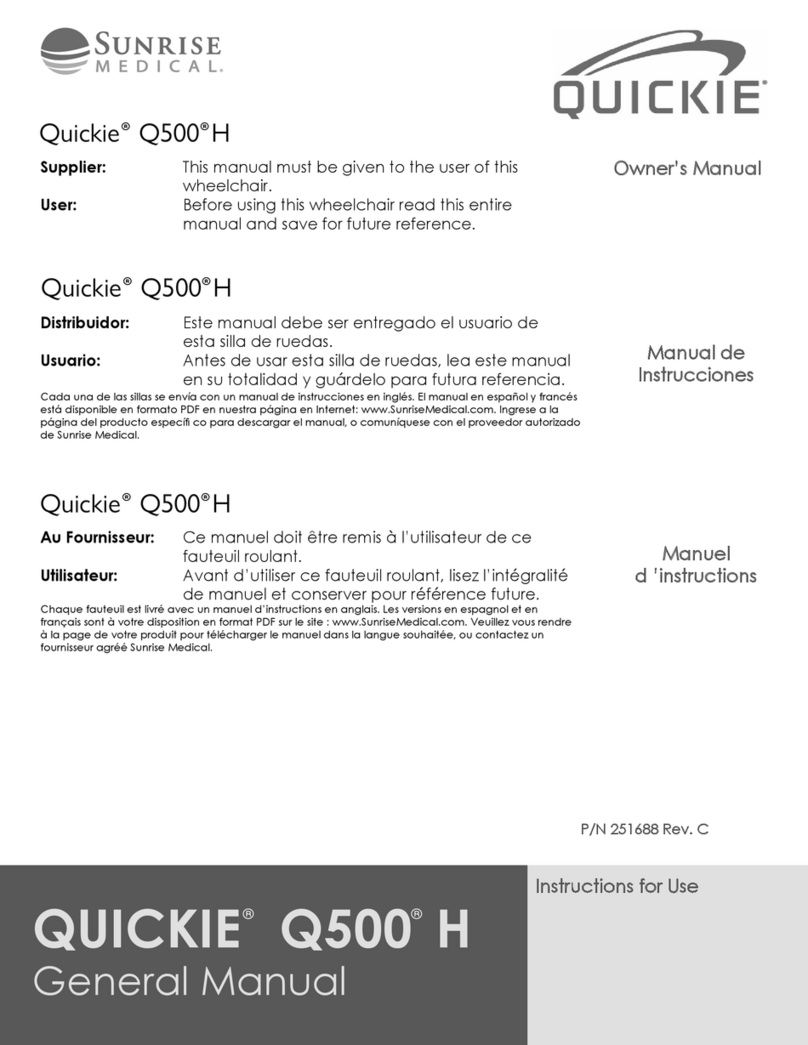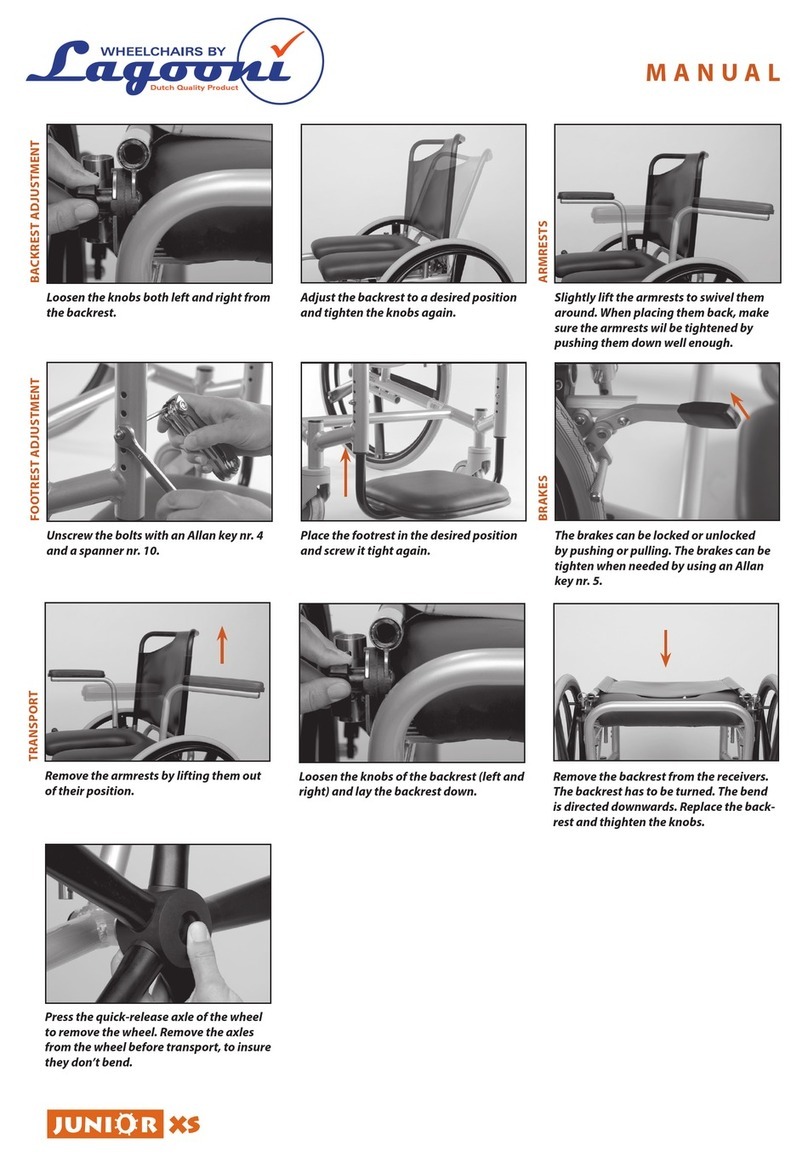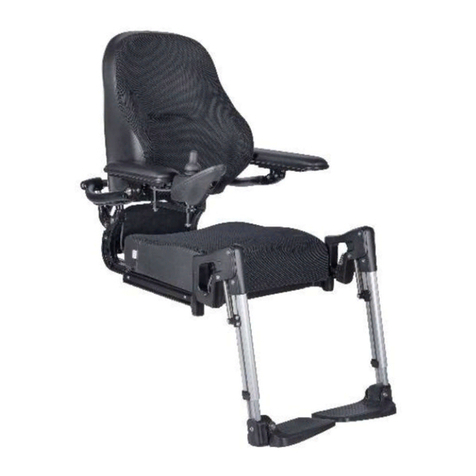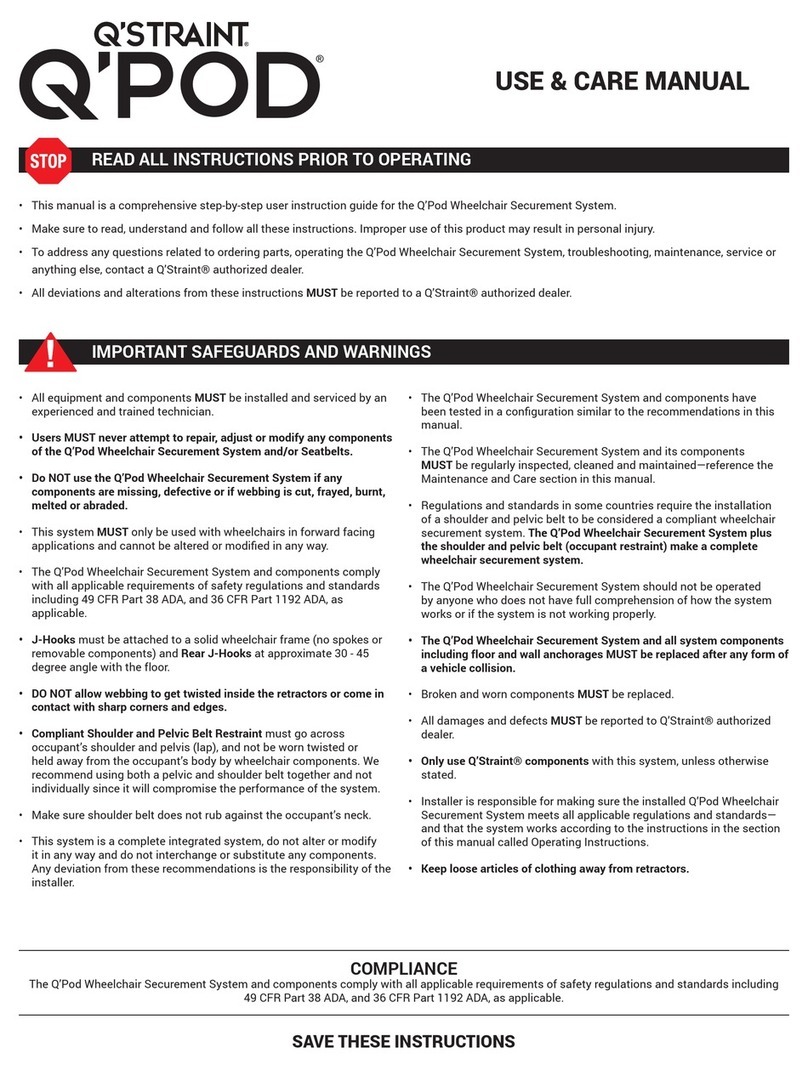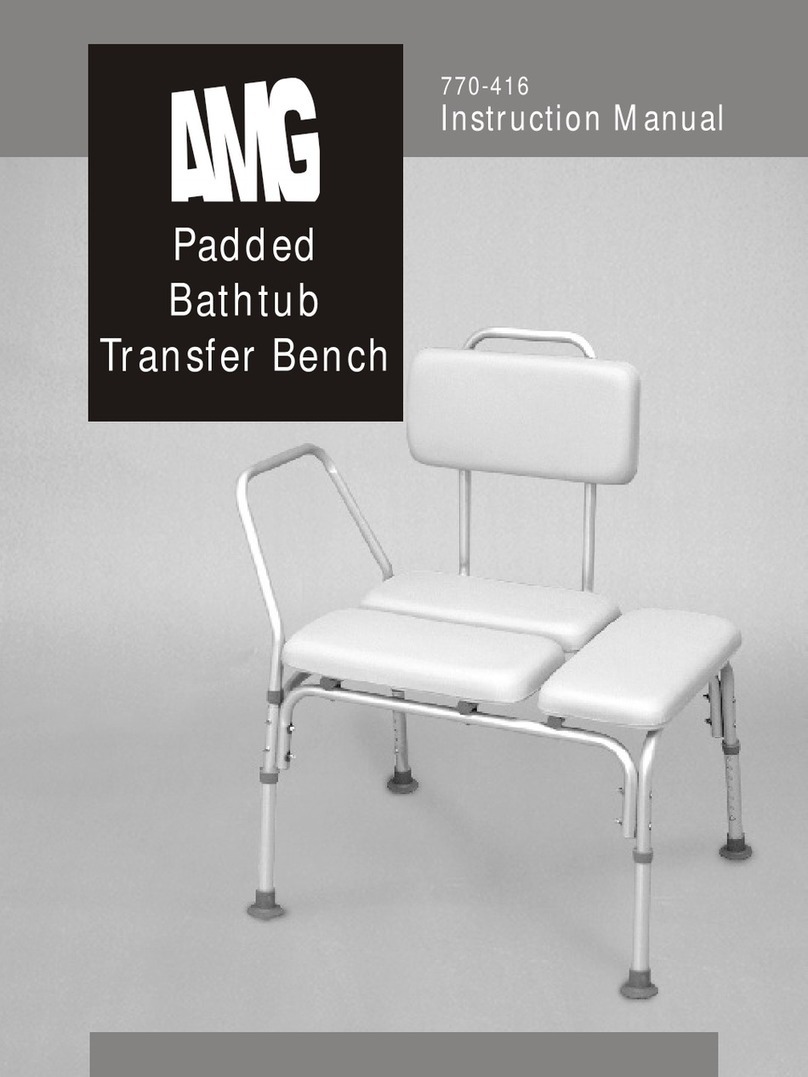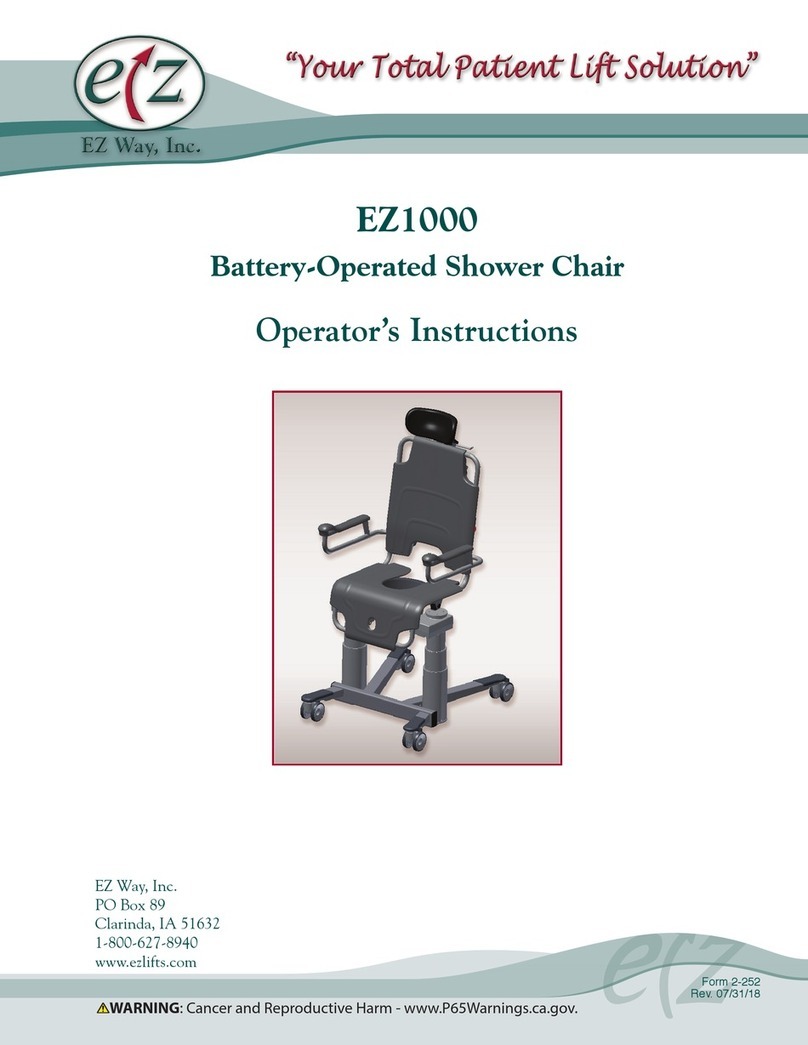Travrsa IKON 40 User manual

IKON Mobility
Operating Manual
Manual Wheelchair Series – Model 40
Distributor/ Manufacturing Representative:This manual must be given to the
caregiver responsible for this wheelchair and its occupant.
Caregiver, Clinician or Social Services:Before using this wheelchair, read this
manual thoroughly and save for future reference.

1. General Information
2. Indications for Use
3. Safety Warnings and Recommendations
4. Product General Description
5. Usage
6. Cleaning
7. Maintenance and Service
8. Warranty
9. Technical Data
10. Set-up and Operation
11.1 IKON Mobility
11.2 General
11.2.1 Wheels
11.2.2 Brakes
11.2.3 Legrests
11.2.4 Armrests
12. Accessories & Replacement Parts
12.1 Anti-Tippers

2. General Information
Dear Customer,
Thank you for choosing an IKON 40 manual wheelchair. This user manual contains a description of the medical
equipment and essential guidelines to ensure the correct and safe usage of the product. Please read and understand
this manual carefully. It is especially important to read the safety requirements and to follow these. This manual will
assist you in making the best use of the capabilities of your chair and will ensure that you quickly become familiar with
its operation.
This document provides guidance on the safe and effective operation of your product.
Information in this manual must be followed at all times.
Anyone involved with the operation or maintenance of the product, including the resident’s family members, must read
this operating manual before using the chair.
The resident’s primary caregiver is responsible for ensuring that anyone who is unfamiliar with, unwilling, or unable to
adhere to the safety and operating instructions, is not permitted to operate or move the chair. A copy of this instruction
manual must always be available.
Travrsa accepts no liability for damages, injury or accidents caused by operating errors, improper maintenance, or
disregard of the instructions in this manual, including any resident specific instructions.
Travrsa reserves the right to make changes to the specifications, dimensions, functions, or components of its products
without notice. Product representations in this manual may vary from delivered products. Each chair has a unique
identifying serial number that must be maintained on the chair as well as with any equipment records.
For questions, please contact your medical equipment dealer or local distributor

3. Indications for Use
The standard IKON 40 is a manual wheelchair device that is intended to be used to provide mobility to persons ages 12
and over (adolescents and adults) with a weight capacity of 300 lbs. The device is to be used as a means of mobility for
persons limited to a sitting position.
The manual wheelchair is a medical device indicated for use by persons with limited motion abilities who are unable to
stand, walk and/or sit independently. The IKON’s use is committed to the transportation and moving of such people in
sitting position. Users can move with the wheelchair independently or with the help of an attendant. The chair can be
used indoor and as well as outdoor on different surfaces (asphalt, concrete, stone and gravel) in good weather
conditions. Any other use of the chair is excluded from possible liability claims.
The IKON should not be used in the shower or bath. The frame and components will rust and will void the warranty. The
chairs are not explosion resistant and must not be used where there are flammable gases or liquids present (e.g.,
anesthetics, volatile solvents and cleaners, etc.) products are designed for use with specific IKON parts and accessories.
The use of non-IKON parts or accessories with the IKON wheelchair may void the warranty and is excluded from
possible liability claims.
The IKON products may only be used as described in this manual and with proper regard for recognized healthcare and
workplace safety and accident prevention practices.
Indications: The device is specifically indicated for individuals who (because of the wide variety of possible health
problems) are unable to stand and/or walk and so they need a transportation device to maintain some or all daily tasks.
Contra-indications: This type of wheelchair must not be used by persons with flaccid paralysis or other diseases that
cause serious body control problems. Such persons require special wheelchairs designed for extra stable support of
the user’s body. The need and possibility of usage of an IKON wheelchair should always be estimated an indicated by
a physician or a physical therapist. The manual wheelchair is a medical device indicated for use by persons with limited
motion abilities who are unable to stand, walk and/or seat independently. It dedicated to the transportation and moving
of such people in a seating position.
Safety and quality standards
The IKON wheelchair has passed all necessary non-clinical laboratory tests and conforms with the following North
American and European Standards:
•ANSI / RESNA WC/Volume 1 – 2009, Section 1: Determination of Static Stability
•ANSI / RESNA WC/Volume 1 - 2009, Section 5: Determination of Dimensions, Mass and Maneuvering Space
•ANSI / RESNA WC/Volume 1 - 2009, Section 7: Measurement of Seating and Wheel Dimensions
•ANSI / RESNA WC/Volume 1 - 2009, Section 8: Static, Impact and Fatigue Strengths Tests
•ANSI / RESNA - ISO 7176-11 Wheelchairs- Section 11: Test Dummies
•ANSI / RESNA – ISO 7176-13 Wheelchairs- Section 13: Determination of coefficient of friction
•ANSI / RESNA WC/Volume 1 – 2009, Section15: Requirements for Information Disclosure, Documentation and
Labeling
•ANSI / RESNA WC/Volume 1 – 2009, Section16: Resistance to Ignition of Upholstered Parts
•CAL117:2013, Section 1: Flammability Testing
•ISO 8191-1:1987 & 8191-2:1988: Flammability Testing
The IKON wheelchair has been tested to the following standards, but are not intended to be used for substantial
equivalence.
•PN-EN 12182:2005
•PN-EN 12183:2010

Spec Sheet per ISO 7176-15 and RESNA WC-1: 2009, Section 15
•PN-EN 1021-1:2007
•PN-ISO 7176-1,3,5,7,8,15
•PN-ISO 7176-19
•EEC 42/93 Medical Devices Directive.

4. Safety Warnings & Recommendations
•The device must not be loaded an occupant with more than 300 lbs.
•Make sure that this user manual is read by all persons using the device. The manufacturer doesn’t take any
responsibility for damages and/or injuries, caused by the fact that the user manual has not been followed.
•Use the product only in good technical condition.
•Use the device only for the purpose as intended.
•Avoid making after-market constructive changes on the device, unless you have the manufacturer’s
expressed written approval for such modifications.
•During different adjustments which are possible on the device, the user must take care not to squeeze fingers
or other body parts between two moving elements of the equipment.
•All wheels should be in contact with the floor at all times during use. This will ensure the device is balanced
correctly and should avoid incidents.
•When using the wheelchair in a stationary position, the hand brakes must be locked
•If defects or errors are detected, you must immediately contact your dealer.
•Follow the instructions and warnings on all product labels.
•The device must only be used on a stable surface.
•Avoid skin burns during usage of the chair in direct sunlight. Various parts of the product might become hot.
•It is not recommended to use the wheelchair on sand, in mud or extreme weather conditions.
•Do not remove by yourself any parts or accessories of the wheelchair. It may influence the product's stability
and rigidity.
WARNING!
The wheelchair is not designed as a seating option for a user in moving vehicles (e.g.
buses, trains, metro, airplanes etc.). It is prohibited to seat on the wheelchair in
moving vehicle. The wheelchair should be safely stowed and secured for the time of
transportation. The wheelchair user should be safely transferred and seated in a
prompt seating system included in the vehicle. It is a great risk of serious incident,
injuries and property damage to not follow the above rule.
The design of the wheelchair because of its functions includes many moving
elements, slots, holes and gaps between the device’s parts. There is a risk of body
part tra
pping during folding, unfolding and adjusting different elements of the
wheelchair. This risk is especially relevant to fingers or hands. It is also possible to
have a finger cut by moving parts of the device. Always be careful when you adjust
or set up a chair to not get your body parts squeezed and injured.

5. Product’s General Description
The IKON manual wheelchair comes with a variety of features: parking brakes, removable & height adjustable
legrests, detachable & height adjustable armrests and it is equipped with rear main wheels, front turning casters,
single or double cross. The wheelchairs are delivered in boxed cartons.The device is made from powder coated steel
or aluminum tubing to protect against corrosion. For some adjustments, you will need some standard tools available in
most hardware stores (Allen wrench).
The wheelchair provides comfortable transportation and storage thanks to its solid cross
frame structure, easy maneuvering, easy transfer in to and out of the wheelchair.
Each standard wheelchair box comes shipped in every package with:
•One main cross frame with upholstery, two brakes, two armrests, two rear wheels
& two front casters
•Two detachable legrests with footplates
•One user's manual
•One Allen wrench
Each individual boxed set of delivered additional equipment depends on individual order
specifications.

Main components:
Above photo shows an example of the IKON wheelchair with all standard components and their position. The exact
appearance of your wheelchair and its features may differ from those shown above (depending on order specification),
but their names, functions and locations should remain the same.
Optional equipment
Depending on version and order specification the wheelchair can be equipped with different wheel types, elevating
legrests, armrests, anti-tipping wheels, seating cushion, and reclining backrest.
Wheelchair assembly:
We recommend the wheelchair to be assembled and set up by a medical equipment professional before it is delivered
to the end user.
Remove all the chair’s elements from the box and check if all components are included according to your order
specification. If you discover that some part is missing or damaged, do not continue the assembly process but contact
your dealer.
How to fold and unfold the wheelchair
To fold: Take the cushion out. Flip up the foot plates.
Lift the upholstery of the seat (left picture).
To unfold: Place both hands on the seat upholstery
tubes and press them down (right picture). You should
be careful and not put your hand between the tubes
and the wheelchair frame when unfolding.
Backrest
Push Handle
Armrest
Wheel Brake
Legrest
Footplate
Folding Cross
(under the seat)
Seat
Rear Wheel
Push Rim
Front Caster
Quick Release
Axle
Anti-Tipper
(Optional)

6. Usage
How to lift the chair
Lift the wheelchair using the push handles and the front upper corners of the wheelchair
frame, where the leg rests are attached.
WARNING Do not lift the wheelchair by holding it by the legrests or the armrests. We
recommend detaching the legrests from the frame before lifting the chair.
Methods to get in and out of the wheelchair
The techniques for transferring the user must be done under the strict supervision of qualified clinical staff.
Our recommended transfer techniques are:
Transferring the user from the wheelchair to the bed
The user should face the bed without regard if the other person helps
or not. Drive the wheelchair as close to the bed as possible and
ensure that front wheels are facing forward. Pull the brake, lift the
armrests/side panels on the side of the wheelchair in
which the
transfer to the bed will take place.
Transferring the user from the bed to the wheelchair
The user should face the bed whether performing an individual or
assisted transfer. Drive the wheelchair as close to
the bed as
possible and ensure that front wheels are facing forwards. Pull the
brake and lift the legrests. Do not step on the footrests, as this may
cause falling out of the wheelchair. The
attendants should
predominantly use leg muscle strength to aid person from the bed to
the wheelchair avoiding the excessive bending down and injuring
their back.
Driving the wheelchair
The correct weight distribution is a basic element of proper wheelchair usage. The correct wheelchair operation
depends not only on weight but also on body proportions, the position of the person seating in the wheelchair and the
position of the rear wheels. The larger the weight proportion of the user resting on the rear wheels the easier it is to
propel. The larger the weight proportion of the user resting on the front wheels the harder it is to propel the wheelchair.
WARNING! Always ensure, that the brake is applied, when the attendant is leaving the wheelchair with the user
sitting in it.
WARNING! Always ensure, that the front casters always point forwards, if the wheelchair stands still, to enlarge
their contact with the base.

How to ride up and over a threshold:
User facing the threshold:
(Only to be performed by experienced wheelchair users)
Drive the wheelchair as close to the threshold as possible
. Incline the wheelchair
backward balancing on the rear wheels and lift the front turning wheels to the height of
the threshold. Push the rear wheels forwards and at the same time lean over transferring
the weight to the front of the wheelchair.
Attendant and user facing the threshold :
The attendant inclines the wheelchair backward by using the step pedal, allowing the
front casters to come off the base. Drive forward until the rear wheels touch the edge.
Use the handles at the back of the wheelchair to lift the rear wheels on the threshold.
Users with their back to the threshold:
(This method will only work with a short threshold and if the legrests do not touch
the ground.)
Drive to the threshold backward until the rear wheels touch it. Push the rear wheels
backward leaning forwards at the same time.
Attendant and user with their back to the threshold:
Drive to the threshold so that the rear wheels touch the edge. Til
t the wheelchair
backward
with use of the step pedal allowing the front casters to come off the base as
much as it is necessary. Pull the wheelchair backward onto
the threshold until the front
casters are above the threshold. Then carefully lower the front casters onto the base.

How to ride over and down a threshold:
User facing the thresholds edge:
We advise that this technique only used by experienced wheelchair users.
Drive the wheelchair as close as possible to the edge.
Balance the wheelchair on the rear wheels allowing the front turning wheels to come off the
base as much as it is necessary. Drive very slowly over the edge carefully lowering the front
turning wheels onto the base.
Attendant and user facing the threshold’s edge:
Incline the wheelchair backward with use of the step pedal allowing the front casters to come
off the base as much as it is necessary. Drive the wheelchair slowly over the edge and
carefully lower the front casters onto the floor.
Users with their back to the threshold:
We do not recommend using this technique over a threshold higher than 4”.
Drive the wheelchair as close as possible to the edge of the threshold.
Drive onto the threshold very slowly leaning forwards at the same time
WARNING! This operation can be dangerous; it can cause the wheelchair to tip over.
Attendant and user with their back to the threshold’s edge:
Drive the wheelchair backward as close as possible to the edge of the threshold. Drive down
from the threshold very slowly and pull back the wheelchair on the rear wheels until the front
casters are free from the edge. Then lower the front casters onto the base.
Max 4”

Overcoming slopes:
Please follow below instructions when driving on a slope:
•Avoid direction changes.
•Try to drive in a straight line. Do not turn sideways.
•Do not hesitate to ask for help to avoid unnecessary risks.
•When driving up the slope lean forwards to transfer the center of gravity to the front making the wheelchair
more stable.
•When riding down the slope lean backward
to transfer the center of gravity to the back making the
wheelchair more stable.
•Control the speed by using the rear wheels' hand-rims, not by using the brakes.
Climbing up and down the stairs:
WARNING! Always ask other persons for help. The wheelchair must be carried by at least two people who are
fit and healthy enough to perform this task.
WARNING! Never ride with the wheelchair on an escalator neither on your own nor with the help of another
person.
Up the stairs:
Push the wheelchair to the stair touching the first step with the rear wheels. Use the
handles to incline the wheelchair backward. The second attendant should grasp the lower
front corners of the frame.
WARNING! Never lift the wheelchair by grabbing the legrests.
Carry the wheelchair slowly up the stairs, step by step. After overcoming the last step
pull the wheelchair backwards until the front casters can be lowered onto the floor. The
attendants should use primarily leg strength to carry the wheelchair to avoid excessive
bending over and back injuries.
Down the stairs:
Carrying the wheelchair down the stairs should be done in the same way as carrying it up as described above.
Vehicle transport recommendations:
The IKON wheelchair is easy to transport in a vehicle. It can be folded and disassembled
to reduce size and weight. The rear wheels and the legrests can be detached and the
chair's cross frame easily folded, as described previously.
WARNING! The wheelchair is not a car seat, do not occupy the chair while in a
moving vehicle. The chair should be folded and safely secured within the vehicle.

7. Cleaning
Frame
The frame should be wiped clean with soap and water. After cleaning the wheelchair should be wiped with a dry rag.
Do not allow the chair to air dry. Leaving the chair to air dry and not ensuring the entire chair is completely dry may cause
the frame and components to rust. Solvents such as those found in spray lubricants should not be used on IKON wheelchairs
as they can damage moving parts.
The frame should be regularly inspected to find damages of the paint which may cause corrosion. In case of any visible
frame damages (cracks, painting defects etc.) ask your local dealer for diagnostics and maintenance.
Upholstery
The seat and the backrest are made of a very durable strengthened nylon. The seat upholstery can be easily extracted by
removing the screws from the frame tubes. The backrest upholstery can be removed by removing the screws from the
backrest tubes. The seat and the backrest upholstery can be cleaned with soap and water.
Normal dirt on the metal and the plastic parts can be removed with standard cleaning agents and sponge or soft rag.
Frequency and method of cleaning the chairs should be determined by facility infection control protocols. If visibly soiled,
thoroughly clean the chair immediately as per the cleaning instructions in this manual.
The cleaning instructions in this manual are guidelines only. Results may vary under actual conditions. The information
does not relieve the user of proper and safe use of the product and all cleaning agents and consideration for the overall
cleaning maintenance of the chair. Cleaning and care instructions must be followed in conjunction with facility infection
control protocols.
Warranty or liability claims on chairs will not be accepted if the product has not been cleaned according to the instructions
or cared for in proper regard for patient, caregiver and third-party safety and hygiene. The use of certain agents may be
harmful to the surface appearance and lifespan of the upholstery.

8. Maintenance & Service
The maintenance of the IKON manual wheelchair will vary with the amount of use and the condition of the resident using
the chair.
In regular use, after the initial inspection and functional testing, the chair should be inspected and tested bimonthly. We
recommend visually inspecting for signs of wear, damage, lose or missing fasteners, and other safety concerns. Periodic
testing of chair functions is also necessary. If a breakage, defect, or operational problem is detected, the chair must be
successfully repaired, inspected and tested for function before it is returned to service.
For basic service actions, a set of socket wrenches, adjustable spanner, flat head- and cross screwdriver will be sufficient.
Parts, which should be regularly inspected:
Part name
Control type
Control frequency
Tires
The condition of tread and tires.
At least once a week
Wheel axles
Remove the hair or accumulated dirt
If necessary
Push Rims
Excessively scratched push rims ought to be exchanged because they
can wound the user’s hands while riding the wheelchair
If necessary
Brakes
The efficiency of brake operation can be affected by dirt accumulated on
tires
. Keep the brakes clean wiping them with a damp cloth to remove dirt,
and also lubricating the funnel of screws, on which the brake levers turn.
Check the horizontal brake position.
Control the correctness of
brake operation at least
once a week
Frame
Keep the wheelchair clean for better comfort of the user.
At least once a month,
depending
on usage
conditions
Turning wheels
The area between the fork and the front wheel should be kept clean
because dirt accumulating there can cause faster wear
of caster bearings.
To do so, one should disassemble the front caster by disassembling it
from the fork, to remove all dirt, and then preserve the metal elements of
the wheel (i.e. to apply technical grease).
The maintenance ought to
be made once a month
or
more often depending on
usual surface type &
conditions
Detachable
elements
Check the condition of detachable elements of the wheelchair, if screws
are loose, they should be tightened.
In case of intensive
exploitation of the
wheelchair the inspection
should be carried out once
a month.

Common problems and solutions
If you notice any irregularities in the wheelchair’s functioning, stop use immediately and contact your distributor or supplier.
The manufacturer does not guarantee the correct wheelchair operation if non-original parts are used.
Symptoms
Possible cause
What to do?
The wheelchair seems
to tilt to one side
•Seat width, depth and chair height
may not fit the user.
•Check displacement of the wheelchair mass
The wheelchair is hard
to push
•Dirty tires or worn treads.
•Front wheels axles are dirty.
•Too large a
load applied on the front
turning wheels.
•Remove dirt or entangled hair from the front
turning wheels axles.
•Move the center of gravity (CoG).
The wheelchair is hard
to turn
•The front wheels horizontal axles are
overtighten
•Front wheels axles are dirty.
•Dirty tires or worn treads.
•Check front wheel axles and loosen them if
necessary.
•
Remove dirt or entangled hair from the front
turning wheels
It is hard to fold and
unfold the wheelchair
•The upholstery fitted to tight.
•The frame cross hinge is dirty.
•Loosen screws which hold upholstery and
retighten them.
•Clean up and lubricate the crossbar hinge.
The wheelchair is not
stable
•
Wheelchair components are not
correctly secured or attached.
•
Ensure that all screws and nuts are tightened.
Flat tire
•Possible puncture of tube & tire
•Tire and tread are worn down.
•Contact your nearest wheelchair dealer to repair
or replace broken tubes and tire.
In case of any product failure, we recommend you contact an authorized service. The manufacturer does not guarantee the
proper functioning of the device if it has been repaired by unauthorized service and/or not using original spare parts.
WARNING! Unauthorized parts or repairs will cause loss a of warranty.
Authorized services:
For authorized repair, contact the dealer where the product was purchased or contact the manufacturer directly.
Procedure for sending the wheelchair or parts to be serviced:
To repair the wheelchair, one should contact the local dealer or the manufacturer. The wheelchair or parts should be sent
in a package protecting it against incidental shipping damages. The best solution is to use the original packaging.
WARNING! The manufacturer does not take responsibility for return shipping damages of the device or
components caused by improper packing.
Storage:
Store devise in a dry place where the temperature is above freezing. The chair can be folded to reduce the space needed
for storage. Freezing temperatures or humidity may cause damages on tires, fabric, axles, bearings and other elements of
the product. To protect tires against deformation during a long period of storage you can place supports under the frame. It
is also recommended to cover the chair to protect it from dust and dirt.

9. Warranty
Effective 1/1/2019
From the date of purchase, Travrsa warrants the side frames and cross members located on the base frame, for the
Expected Lifetime* of the original purchaser/ user, when purchased from an Authorized Dealer.
*Expected Lifetime of the frame is 7 years.
Travrsa warrants the other product components, except the seat cushion and backrest (which are not warranted), to be free
from defects in materials and workmanship for a period of 2 years from the date of purchase, as indicated on the original
purchase order. This warranty is non-transferable.
The warranty is subject to the following conditions:
If within such warranty period any such product shall be proven to be defective through examination, inspection and testing
as deemed necessary, such product shall be repaired or replaced at Travrsa discretion. This warranty does not include on-
site labor.
A serial number, purchase order or invoice number is required for warranty coverage.
The warranty shall not apply to serial numbered items if the serial number has been removed or altered in any way.
Warranty is valid for “new” purchases only. All other items will be warranted at the sole discretion of Travrsa.
Limitations and exclusions:
This warranty does not cover damages that arise from improper handling, cleaning, maintenance, storage or negligent use.
The warranty does not cover IKON wheelchairs and chairs used in any way, other than the manner in which it was designed
and recommended.
Modifications, incorrect assembly or installation to IKON products or the use of non-IKON products voids the warranty.
Installation of parts that require the frame to be altered in any way must be completed by an authorized representative,
unauthorized performances will void the warranty.
Travrsa retains the right to make product design and product application changes without notice.
The application and use of IKON products shall remain the responsibility of the purchaser or user. Please reference the
operating manuals for safety requirements, inspectional and functional testing, technical information and more.
Warranty does not include on-site labor for the installation of warranty parts or warranty repairs. The owner may return
products for warranty replacement or repair by shipping items prepaid and insured to the factory. Warranty completed at
the factory includes both materials and labor. The decision to repair or replace parts is at the discretion of Travrsa. All
returns to the factory require prior authorization from Travrsa.
Damaged freight:
This warranty does not cover freight damage. It is the responsibility of the product owner upon receive to examine the boxed
cartons and products before accepting receipt. Note all damages on the bill of lading and file a claim if necessary. Notify
the carrier of any concealed damage within 48 hours of receipt.
Travrsa ensures all products for in-transit damage, failure to notify the carrier of in transit damage voids both the insurance
and the warranty. Pictures are required for all damaged freight claims.
Return policy:
By request, products must be returned to the factory via the same freight mode/service as delivered, pre-paid and insured,
within 30 days. Failure to do so will result in the owner incurring the cost of the replacement parts. Products must be in new
condition – no damage, dirt or alterations.

10.Technical Data
Technical data will vary according to the frame dimensions and the way the wheelchair is set up (front and rear wheels).
Standard IKON*: 18” seat width, 8” front castor and 24” rear wheel.
Specification
IKON 40
Cross bar
*1 x 1
2 x 1
Seat widths
16", *18"
20", 22"
Seat depths
16"- 22" Adjustable
16"- 22" Adjustable
Seat height
14”, 15”, 16”, 17”, 18", 19”
Adjustable
14”, 15”, 16”, 17”, 18", 19”
Adjustable
Max user weight
300 lbs.
300 lbs.
Chair length
40"
40"
Chair width
26"
26"
Length (no legrests)
30"
30"
Folded height
34.5"
34.5"
Folded width
13.5"
13.5"
Total weight (Including legrests, armrests and
anti-tippers)
34 lbs.
34 lbs.
Front seat height
16"
16"
Backrest height
16.5"
16.5"
Legrests
*Swing Away
Elevating
Swing Away
Elevating
Legrest range
13.5"- 19" Adjustable
13.5"- 19" Adjustable
Legrest angle (°)
70°
70°
Footrests
Flip Up and Angle Adjustable
Flip Up and Angle Adjustable
Armrests
*Flip Back Adjustable Height
Fixed Non-Adjustable
*Flip Back Adjustable Height
Fixed Non-Adjustable
Armrest height range
9"- 11" Adjustable
9"- 11" Adjustable
Rear wheel
*22", 24” Spoke
22”, 24” Composite Mag
*22", 24” Spoke
22”, 24” Composite Mag
Front wheel
5”, 6”, *7", 8” Castors
5”, 6”, *7", 8” Castors

11 Wheelchair Set-Up and Operation
11.1 IKON Mobility System
The IKON 40 has a seat depth adjustable frame with multiple wheels, axle and front caster set up options for use by
active self-propelling drivers to rehabilitation purposes, where a high degree of control, support and stability is required.
Frame settings
The frame design allows a wide adjustment range of seat angle, height and depth, as well as different degrees of stability
by adjusting the wheelchair’s Center of Gravity (CoG) relative to the rear wheel axle position.
•Moving the axle position closer to the CoG makes the chair easier to tip and more “responsive” for the active
wheelchair drivers.
•Moving the axle position further away from the CoG makes the chairs less likely to tip and suitable for users who
need more stability and safety.
To accommodate taller and shorter users, the seat depth can be changed by adjusting the seat tubes and the upholstery.
The frame design allows for extensive adjustments of the seat angle, the seat height and the seat depth. You can
change:
•the angle and/or the height of the seat by changing to another diameter front caster and/or rear wheel.
•the angle of the seat by changing the position of the rear wheels.
•The angle of the front fork axle to adjust it perpendicular to the floor.
•The seat depth by horizontal adjustment of the rear wheel axle position; this allows influencing the stability and
maneuverability of the chair.

WARNING! All below adjustments should only be made by qualified service person and/or advised by a physical
therapist qualified in wheelchair setup.
Adjustment of rear wheel height
•Detach the rear wheel using the quick release button.
•Unscrew the wheel bushing (1) from the black assembly plate and insert it into one of the other holes.
•Tighten the bushing on the plate maintaining the correct order of washers and nuts
•Repeat all above for the other wheel.
Horizontal adjustment of the rear wheels
For users who need increased stability, e.g. after lower extremity amputation, the axle plate is moved rearwards relative
to the seat frame. It is recommended to use anti-tip supports to protect the wheelchair against tipping over. Note also
that a longer wheelbase makes maneuvering with the chair more difficult.
To increase the maneuverability and responsiveness, the axle plates can be moved to the front position. It is easier to
maneuver with a wheelchair when the rear wheels are in a front position, but the rearwards stability is much lower. If the
wheels are adjusted to the front position, the wheelchair should always be equipped with activated anti-tip supports to
protect it against tipping over. Persons with amputated leg(s) should never use the chair with wheels set in a front position
as the risk of tipping over is too high.
The position of the wheel assembly plate can be changed to six other positions relative to the back cane assembly (10)
•Unscrew bolts (3) & (4) which hold the wheel assembly plate to the frame tubes.
•Move the wheel assembly plate to the required position (forward or rearward), then reinsert and tighten the bolts.
•Repeat all above for the other side of the frame.
WARNING! If the position of the rear wheels is changed, it is necessary
to adjust the brake’s position
accordingly.
1
3
4
5
6
8
9
10

WARNING! Settings on both sides of the frame should be identical.
The seat depth is determined as the distance from the lumbar spine to the knee crease, less an adequate amount of
space to give clearance for clothing and free space so as not to impede blood circulation at the back of the knee.
WARNING! All below adjustments should only be made by a service person and/or advised by a clinician
qualified in wheelchair maintenance and setup.
Adjustment of seat depth
This is done by moving the rear back cane assembly (10) over the top rail of the side frame. PLEASE NOTE: the rear
axle assembly (4) needs to be repositioned to ensure functional stability for the user.
If the crossbar (5) is to be moved back after moving of the back-cane assembly (10), please ensure the front of the seat
tubes are supported on the side frame by moving the front seat tube support (9) rearward on the side frame ends. To
make the adjustments:
•Loosen bolts (5) & (6) which attach the cross to the frame.
•Slide the crossbar with seat tubes to the required position.
•Reinsert and tighten all bolts to secure the cross and armrest bracket in the new position.
•Repeat all above for the other side of the frame.
Along with the crossbar, the seat tubes have been moved during that adjustment. Ensure that the seat tube supports are
in proper position supporting the tube ends so that all the four corners of the seat are stable:
•Loosen the bolt (8).
•Move the support (9) into the position to provide stable support for the front end of the seat,
•Then tighten the bolt (8).
•Loosen the three bolts which attach the seat and backrest support (10) to the frame.
•Move the support (10) into the position it provides support for the rear end of the seat. Then tighten the three bolts.
•Repeat all above for the other side of the frame.
1
3
4
5
6
8
9
10
Table of contents
Popular Wheelchair manuals by other brands
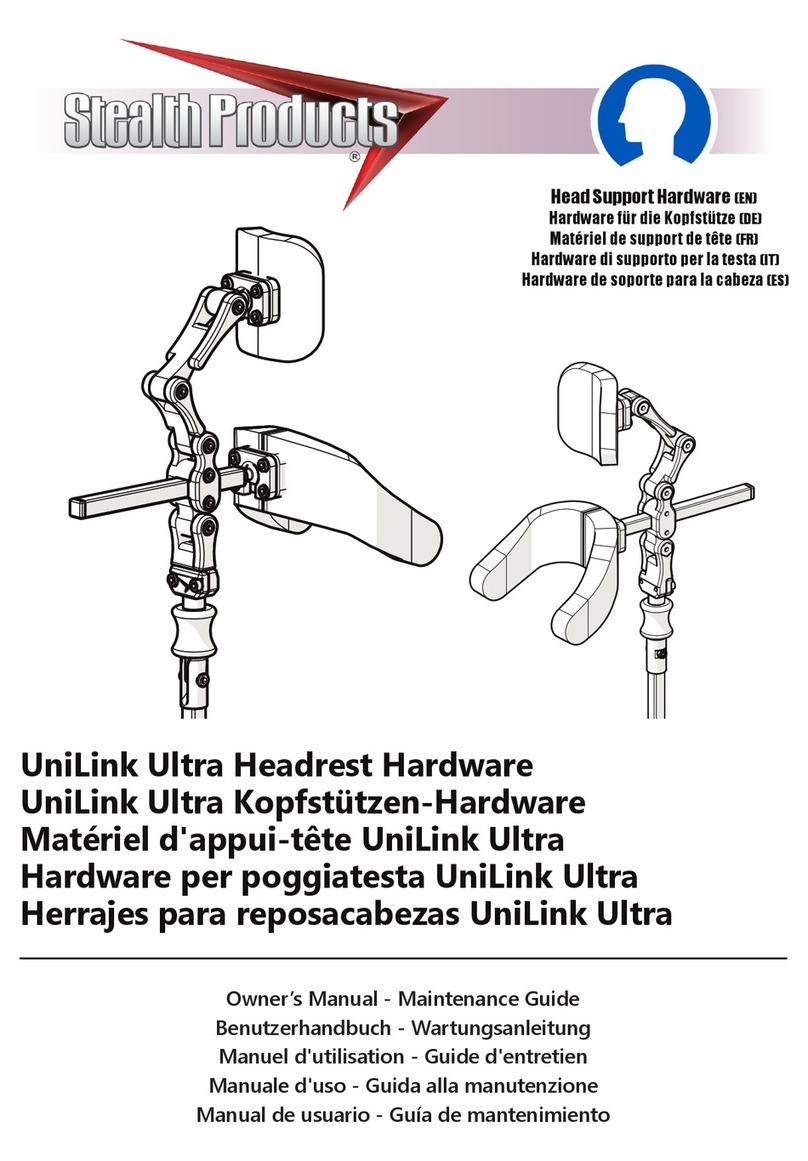
Stealth Products
Stealth Products UniLink Ultra owner's manual

Otto Bock
Otto Bock Motus Instructions for use
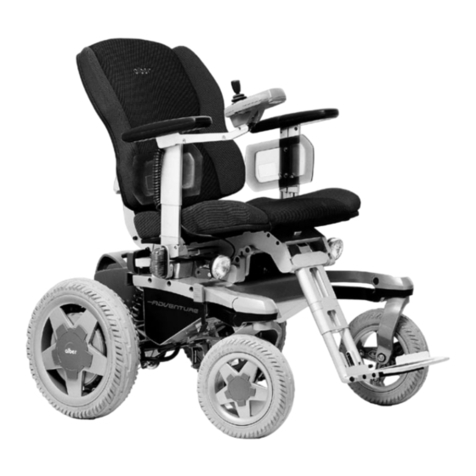
Alber
Alber Adventure A10 Technical documentation
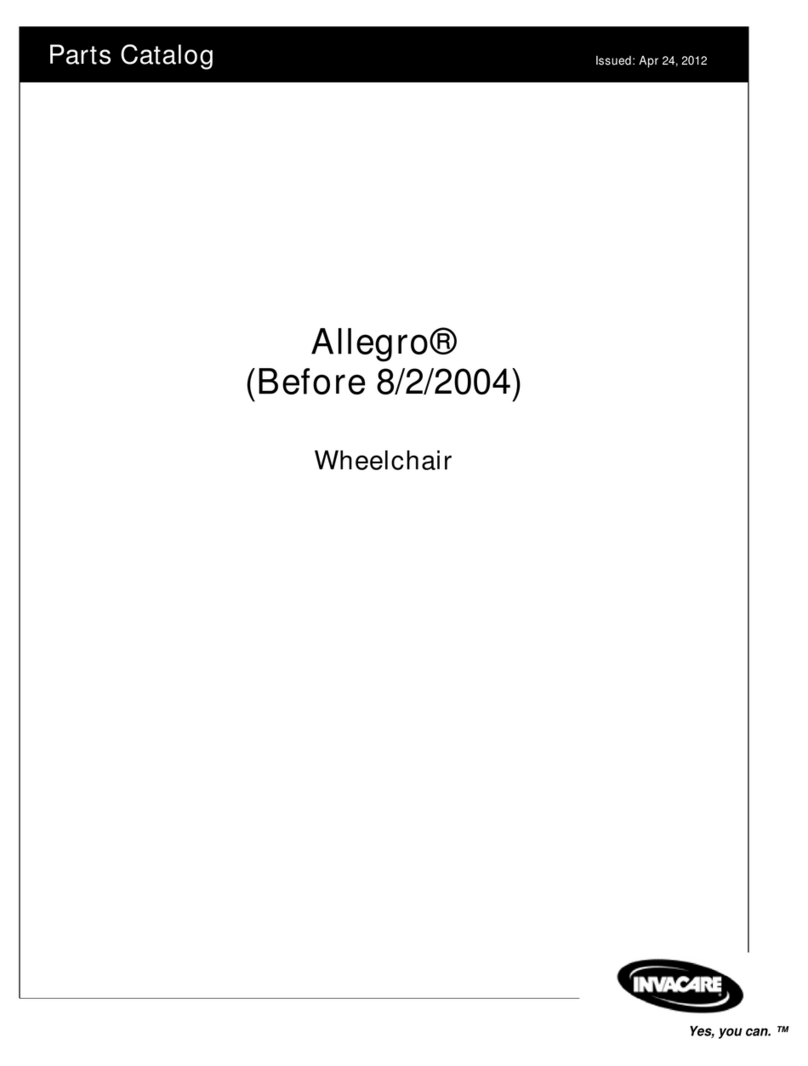
Invacare
Invacare Allegro parts catalog

Permobil
Permobil M1 user manual

Sunrise Medical
Sunrise Medical Quickie Ti Titanium Instruction manual and warranty
